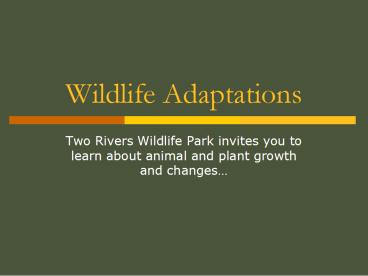Wildlife Adaptations - PowerPoint PPT Presentation
1 / 15
Title:
Wildlife Adaptations
Description:
Wildlife Adaptations. Two Rivers Wildlife Park invites you ... In other words, wildlife includes all living things that are not domesticated, including plants. ... – PowerPoint PPT presentation
Number of Views:140
Avg rating:3.0/5.0
Title: Wildlife Adaptations
1
Wildlife Adaptations
- Two Rivers Wildlife Park invites you to learn
about animal and plant growth and changes
2
What is Wildlife?
- What do you think of when you hear the word
wildlife? - Does the word wildlife include only furry
animals?
3
Wildlife is..
- Wildlife includes wild mammals, birds, reptiles,
and amphibians. - It also includes fishes, plants, fungi, algae,
bacteria, and other wild organisms. - In other words, wildlife includes all living
things that are not domesticated, including
plants.
4
Habitat is Home!
- Habitat is very simply where an animal or
plant lives its home.
We generally think of habitat as being made up of
four main things food, water, shelter, and
space.
5
What is an adaptation?
- Animals have special behaviors and body parts
that help them get food, keep safe, and live in
their habitat.
These special behaviors and body parts are called
adaptations
6
Physical Adaptations
- Adaptations can be physical or behavioral
An example of a physical adaptation is when an
animal changes colour to blend in with its
habitat or when a leaf changes colour.
Arctic fox are blue/grey in the summer and turn
white in the winter!
Leaves turn colour in the Fall to protect them
from the cold.
7
Behavioral Adaptation
One behavioral adaptation is hibernation. Some
animals hibernate to survive the winter. They
slow their heart rate and breathing so much its
hard to tell that they are still alive!
Hibernates...
Aestivates
Groundhogs and bats are the only true hibernators
in Nova Scotia. Bears aestivate (es-ti-vate),
which is not as deep a sleep as hibernation.
8
Adaptations you otter know about! Are these
physical or behavioral adaptations?
- An otter is home in the water. Their eyes
are high on their head to see while swimming just
under the water.
Their ears close underwater.
They have rough patches on their feet to get a
better grip on slippery surfaces.
They have fur that is insulated and
waterproof.
9
Some reasons why wildlife changes or adapts
- They adapt to live in their habitat
- They adapt to survive and thrive in their
habitat - They adapt to protect their babies
10
Hot Habitats
- Some plants and animals need to adapt to
survive in extreme habitats.
To survive in the desert the cactus stores
water to use when it is hot and dry for long
periods of time.
11
Adapt to the Habitat!
- Some wildlife adapt to their habitat by moving!
This change of habitat is called migration.
Many birds migrate south for the winter.
Migration is considered a behavioral adaptation.
12
Surviving and Thriving in a Habitat
- The bracken fern has many adaptations to help
it survive and thrive in its habitat. Below are
two
1. The plant encourages fires which burn away
competing plants.
2.The plant can be poisonous to animals and other
plants.
How do you think these two adaptations help the
fern survive and thrive?
13
Protect their young in a habitat
- Penguins have adapted to protect their young
in very cold weather.
They can cover the egg with their bodies and move
it with their beak and feet!
14
How do you Adapt to your Habitat?
- Do you dress differently from season to season?
How do you get ready for winter? - How do you get around? Do you take a bus? Walk?
Have your legs become stronger from walking? - What adaptations can you think of?
15
To Learn More about Adaptations
We hope you enjoyed this presentation about
animal and plant growth and changes. Complete the
activity sheets and then visit Two Rivers
Wildlife Park to learn more! Hope to see you s
oon!





























![get [PDF] DOWNLOAD Wildlife Population Health PowerPoint PPT Presentation](https://s3.amazonaws.com/images.powershow.com/10088088.th0.jpg?_=20240729021)

